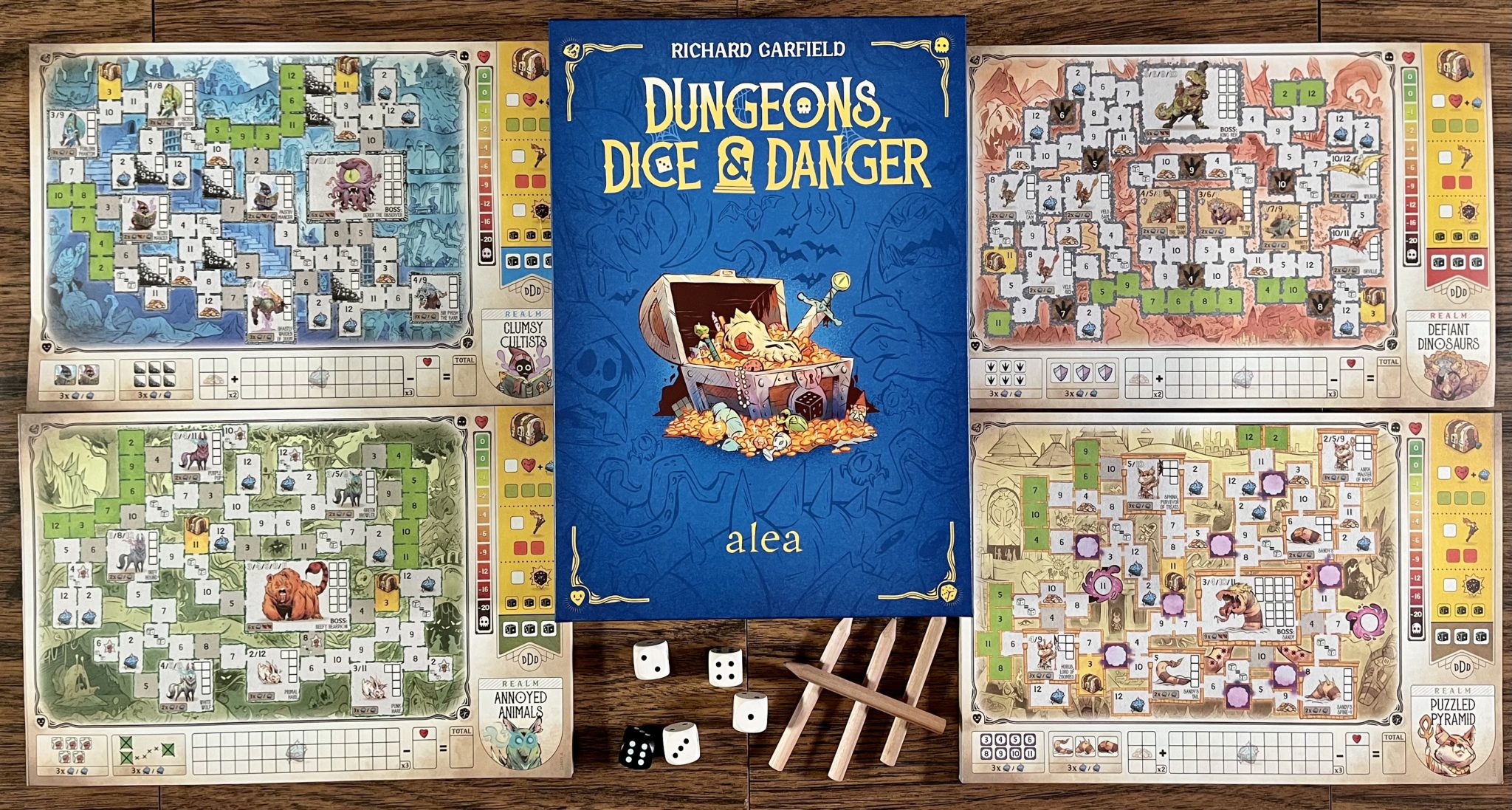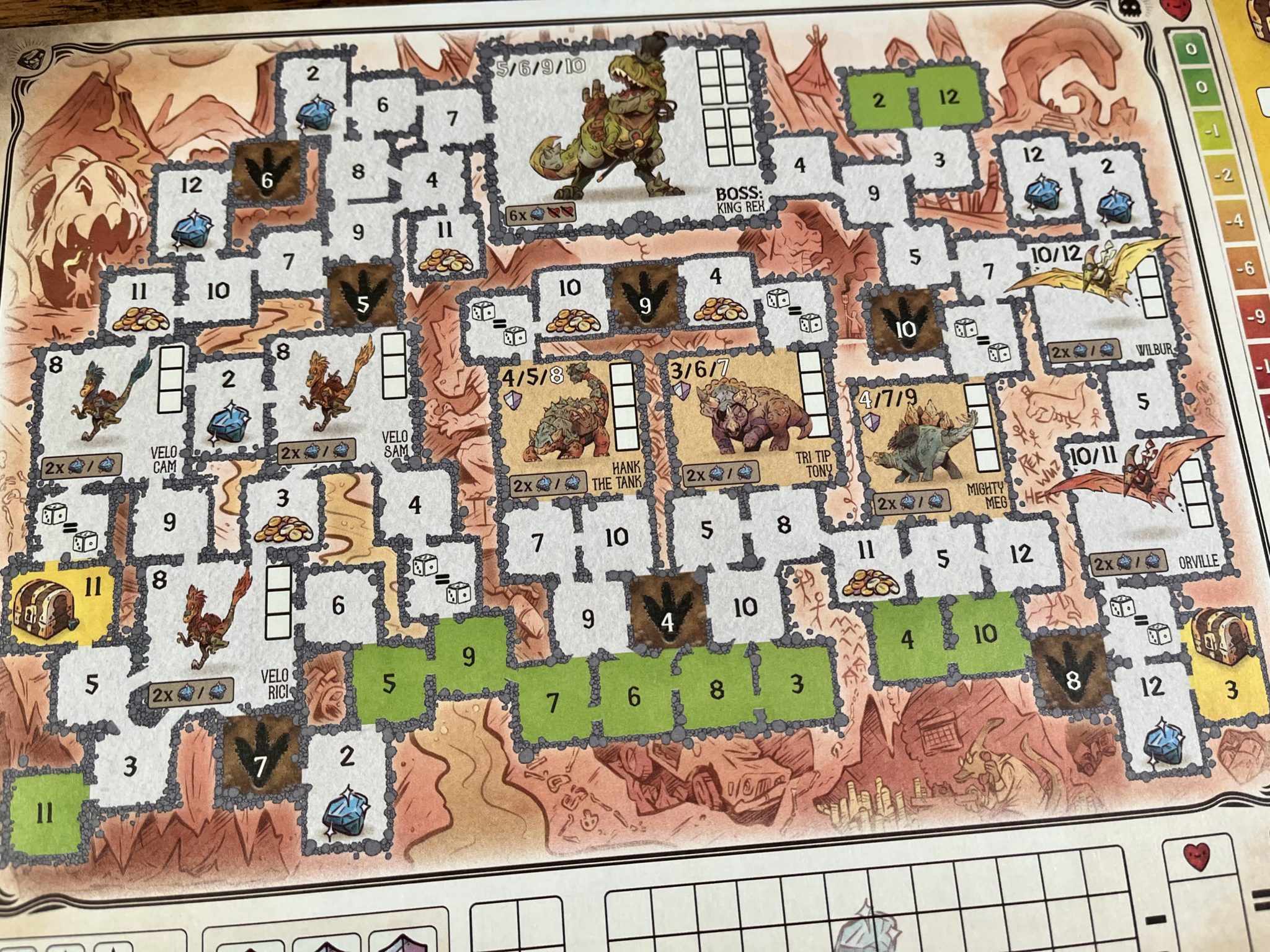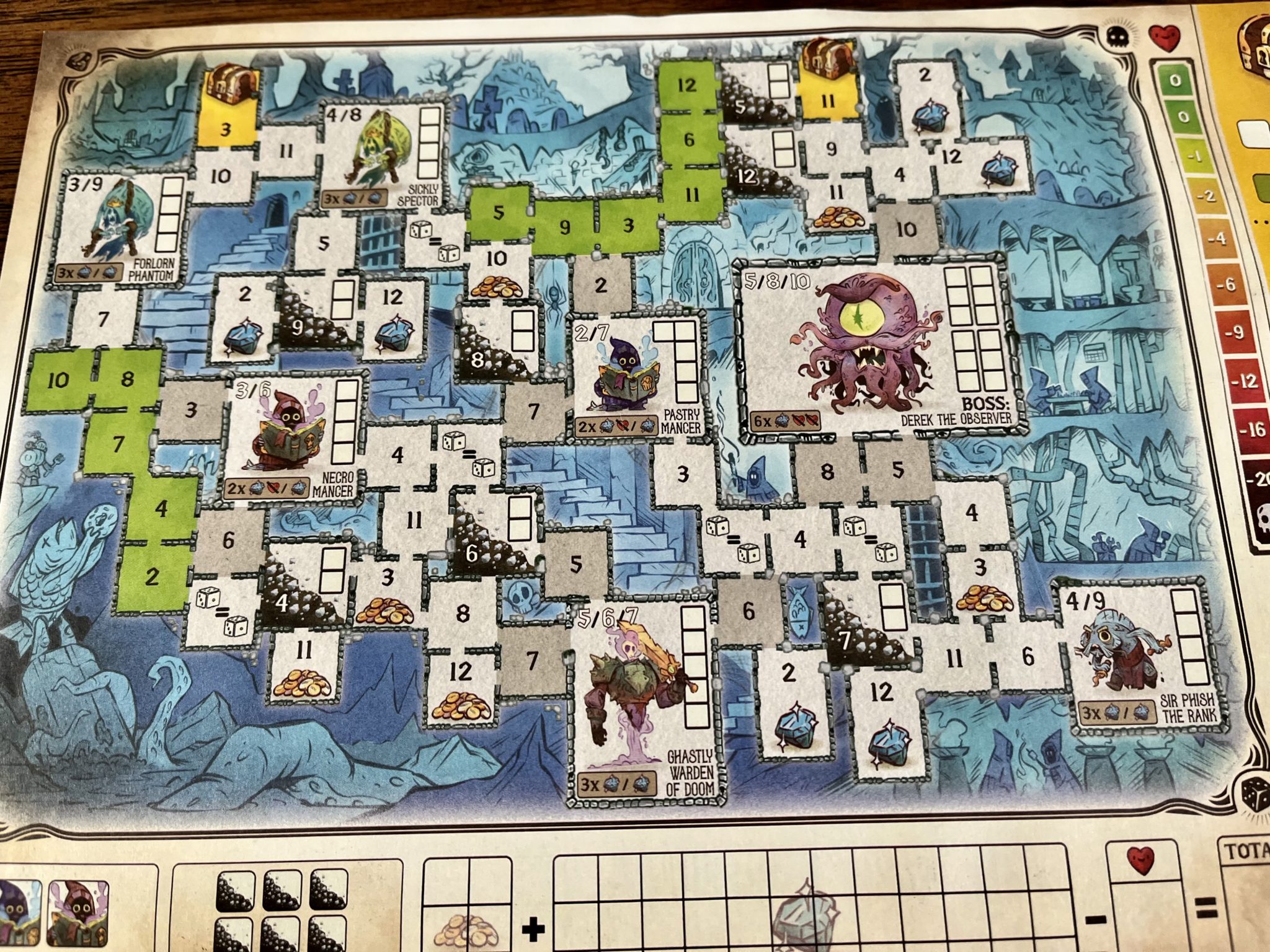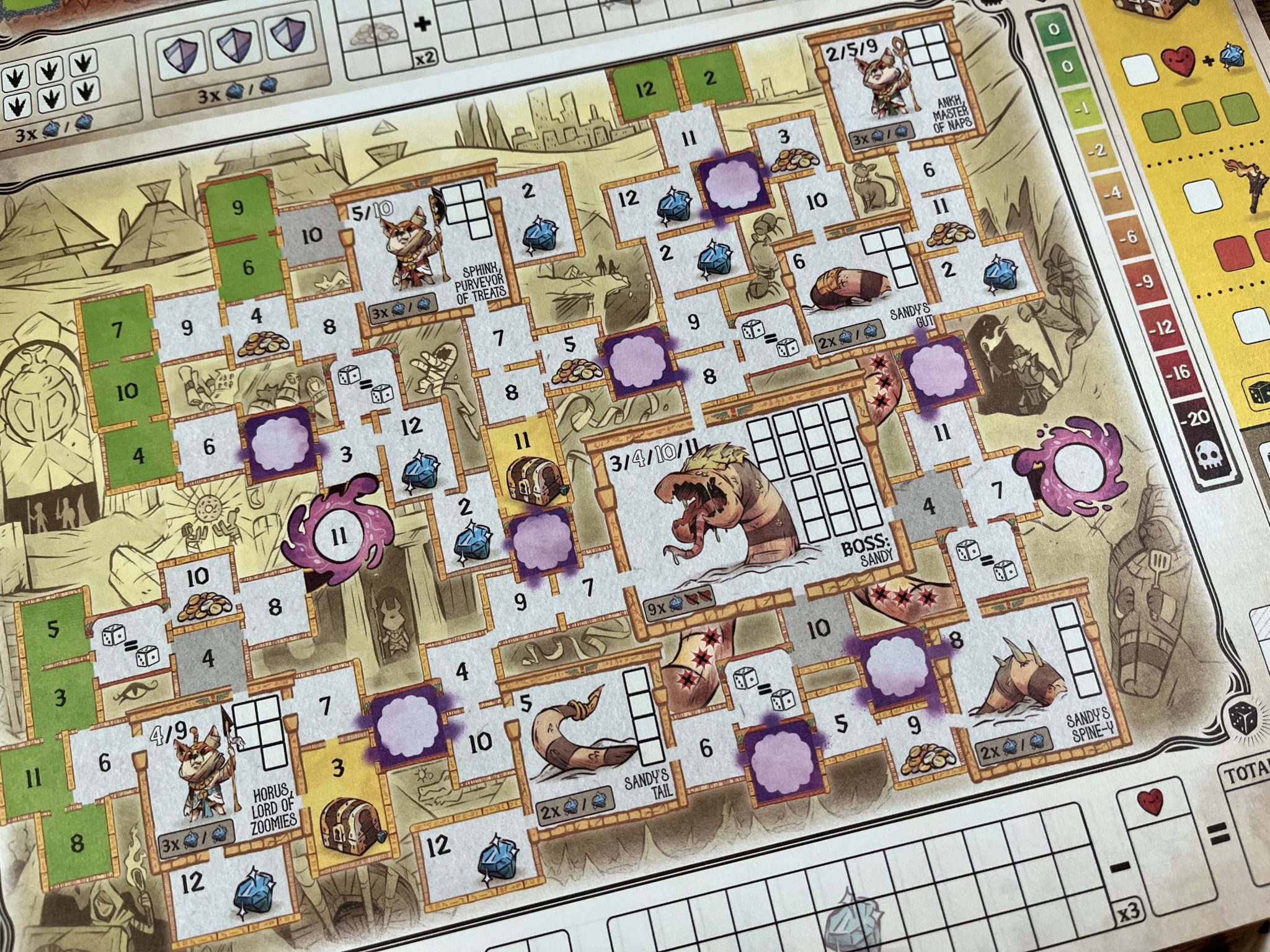Dungeons, Dice & Danger is a roll and write game developed by Alea, and published by Ravensburger. This game uses dice, a pencil, and a piece of paper. You have heard the legends for a long time, and you know about the potential treasures that can be found. Adventure and glory beckons you, although rumors of monsters have always held you back. Until now, where you gather your courage and face your fears in this 1-4 player roll and write game.
What’s in the Box?
- 200 Adventure Sheets (50 per Adventure type)
- 5 Dice (4 White, 1 Black)
- 4 Pencils

How’s it Play?
This is a roll and write game so players start with their own adventure sheet and a pencil. All players need the same adventure sheet type, and players are trying to gain points but collecting treasures, defeating monsters, and completing goals in the game.
The first player rolls the 5 dice, and that player, who we will call the active player, can form 2 pairs of dice using any of the 5. They will of course have one die they won’t use. All other players form 2 pairs but only using the white dice to do so.
Each player has a couple slots where they can mark off their black dice ability to use the black die with their pairs when they are not the active player. You can only do this the number of times that you have a black die ability icon to cross off.

The totals of the pairs dictate which boxes they can cross off on their sheet. At first, all players can cross off any start spaces with the matching number, and as the game develops , can cross off any adjacent spaces to an already visited space.
If you cross off a space with a gem, you can cross off one of the squares on the bottom of your sheet matching that gem. Gems are worth 3 points each at the end of the game. Gold is similar, but is worth 2 points each at the end of the game.
To fight monsters, you need to be adjacent to them a roll one of the solid numbers in its space. When you cross off a shaded space near a monster, you can fill in that number on the monster box, which can then be used to deal damage to that monster. Each time you have a pair that matches one of the filled in numbers for that monster, you fill in one of their boxes. Some monsters are easier than others, so be strategic on how you go about doing this.
When defeating a monster you claim the reward of the first higher stated reward, and all other players cross it off their sheet. If another player later defeats the same monster, they receive the lower reward listed. In addition, when the first player defeats this monster, all other players deal it 1 damage, even if a player hasn’t connected their path to that monster themselves yet. If a monster has a crossed out heart symbol, when they defeat that monster they will be dealt damage equal to the number of those icons

If you ever can’t use a formed pair to cross off a space on your sheet, you take damage and fill in the top most space on your health meter. With time, you might lose more and more health, which will be negative points at the end of the game.
Some spaces require doubles, some require doubles that equal a certain number. Spaces with a fist deal 1 damage to all monsters in the map including ones you haven’t reached yet. Some maps give points for connecting the 2 starting areas. You can gain points for defeating certain monsters before others. Rubble spaces are crossed off when both boxes have been visited.
Other adventures have cloud spaces where you write in numbers randomly, and then when completing them gain a reward. The number 11 cloud space unlocks the other blank cloud space to give access to that side of the map. And if a player defeats 1 of 3 worm spaces, they deal 3 damage to Sandy the boss monster.

Defiant dinosaurs adventure has claw spaces. When crossing off a space with one of those, it unlocks the monster’s room by checking off the corresponding white number. To deal damage to an armored dinosaur, a player has to use both pairs dealing it 2 damage. There is a gem reward for the player who defeats their 3rd armored dinosaur. And there is a gem reward for visiting 6 out of 7 claw spaces.
Treasure chests give one of the rewards shown on the side of their player sheet. They cross off the white box and get access to the rewards. Extra life lets players mark off these boxes before they go back to taking damage on their own health meter. A torch allows a player to cross off any space adjacent to where they have visited or to deal 1 damage to a monster. This is done without using dice to do so. And lastly, you can gain the reward of extra black dice abilities when you’re not the active player.

The game ends when when the first player defeats their last monster or when all monsters have been defeated by at least one player — I’ve seen it explained both ways. For players who haven’t defeated the boss monster, they gain 3 points for every 3 damage dealt to it, Elsewhere, they explained this as gaining 1 point for each 3 damage. This was unclear, but perhaps it can be played either way.
Players then count up points by filling in the bottom section. Gold times 2, gems times 3, minus your health points, plus points from unfinished boss monsters, and the player with the most points, wins the game.
There is a solo mode player the same way except they roll all 5 dice but only use the black die when using their black die ability. Also, you lose 1 life point if you don’t deal damage to at least 1 monster during each round. You can compare your score to the chart in the rulebook to see how well you performed.

The Verdict
The game is a fun dungeon crawler lite game. You need to manage which spaces you can access to better use whatever results are rolled on the dice. But, the game also is a race with other players to defeat monsters first, or accomplish goals first. You might even need to keep an eye out to see what all the other players are doing to form a better strategy as to where you go. You will want to visit those shaded spaces to have more possible results to deal damage to monsters, but you also want to continue preparing other avenues, so you don’t always need to unlock all shaded areas before defeating a monster.
I like that Dungeons, Dice & Danger provides 4 different maps, so although the game is pretty similar one from another, you have different adventures you can go on. Each map also introduces some newer mechanics or goals that can make it feel a tad different.
We enjoyed Dungeons, Dice & Dungeons, and with 4 maps, the joy lasted longer than it would if there was only 1 map. But, the game is what it is. You roll dice, and fill in spaces. You can be strategic in how you go about this, but the planning is pretty linear and flat, which is pretty typical for a roll and write game. The map lets you feel like you are exploring, which really isn’t true, but the art and layout helps give it that dungeon crawler theme. With all that combined together, the game then also has some negatives. The game lasts way longer than it should, you feel like your attacking the monsters the entire game, and never finishing one and moving on to the next. And if you are focusing on just one, then you are sure to lose the game.

The game is more about trying to mark off squares that will open up more possible options for the future. When you have limited numbers, then you take damage yourself, and also don’t progress on your map, while all others will. So always try to extend your exploration further if possible, or at times finish off the monster before another player does.
I’d like to see the game somehow use different weapon types to deal different types of damage to the monsters, but again, they would involve a more complex game. The game also is a multiplayer solitaire game, which really means you don’t really interact with any of the other players all too much. But the game is all about what it’s title suggests: dungeons, dice, & danger.

Images via Ravensburger
Have strong thoughts about this piece you need to share? Or maybe there’s something else on your mind you’re wanting to talk about with fellow Fandomentals? Head on over to our Community server to join in the conversation!

